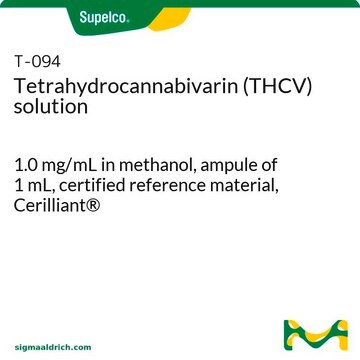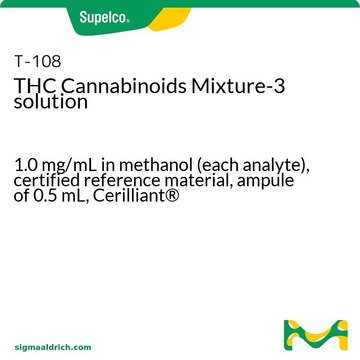39382
Delta9-Tetrahydrocannabinolic acid A
analytical standard
Synonyme(s) :
THCA-A
About This Item
Produits recommandés
Qualité
analytical standard
Niveau de qualité
Pureté
≥97% (HPLC)
Durée de conservation
limited shelf life, expiry date on the label
Contrôle du médicament
USDEA Schedule I; Home Office Schedule 1; regulated under CDSA - not available from Sigma-Aldrich Canada
Technique(s)
HPLC: suitable
gas chromatography (GC): suitable
solid phase extraction (SPE): suitable
Adéquation
corresponds for H-NMR
Application(s)
forensics and toxicology
pharmaceutical (small molecule)
veterinary
Format
neat
Température de stockage
−20°C
Chaîne SMILES
CCCCCc1cc2OC(C)(C)C3CCC(C)=CC3c2c(O)c1C(O)=O
InChI
1S/C22H30O4/c1-5-6-7-8-14-12-17-19(20(23)18(14)21(24)25)15-11-13(2)9-10-16(15)22(3,4)26-17/h11-12,15-16,23H,5-10H2,1-4H3,(H,24,25)/t15-,16-/m1/s1
Clé InChI
UCONUSSAWGCZMV-HZPDHXFCSA-N
Application
Code de la classe de stockage
11 - Combustible Solids
Classe de danger pour l'eau (WGK)
WGK 3
Point d'éclair (°F)
Not applicable
Point d'éclair (°C)
Not applicable
Équipement de protection individuelle
Eyeshields, Gloves, type N95 (US)
Faites votre choix parmi les versions les plus récentes :
Déjà en possession de ce produit ?
Retrouvez la documentation relative aux produits que vous avez récemment achetés dans la Bibliothèque de documents.
Les clients ont également consulté
Notre équipe de scientifiques dispose d'une expérience dans tous les secteurs de la recherche, notamment en sciences de la vie, science des matériaux, synthèse chimique, chromatographie, analyse et dans de nombreux autres domaines..
Contacter notre Service technique








